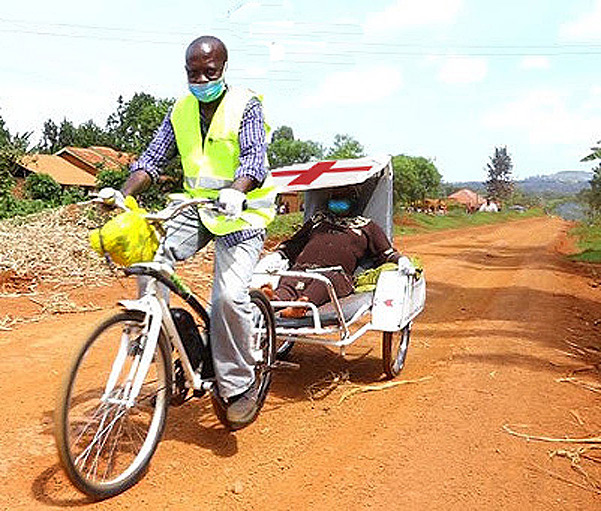|
In view that Coronavirus remains the 'bug of the month' and that the
ban on public meetings effectively continues, nothing much again in normal Surrey Vintage Vehicle Society gatherings. We have therefore encouraged all
our members to take
photographs instead of any of their allowable distancing machinery and share them on
our website. Many of our
Members are of the 'elderly variety' so were hankered deep down thinking of
survival rather than escape, but some have been 'socially cycling' and
have sent photos to
us. The cycling theme continues! PHOTOS WELCOME !!
A few years after Queen Victoria was born, a Baron Karl von Drais got fed up
with daily walking through the German forests he was managing. He needed personal
transport and at that time everything was horse powered. The only problem was that recent massive
food famines caused by the eruption of Mount Tambora and due to the massacres in the
Napoleonic Wars, there was now a great shortage of horses, many having been
eaten. Being in great need, had the bright idea
of putting two cart wheels one in front of the other, rather than side by
side, and basically putting a plank of wood between them. Thus in 1817 he
invented the bicycle, or as he called it, a Laufmaschine, a 'Running Machine',
the first mechanized personal transport.
Chain and pedal having not yet having been invented, the concept was that you
sat firmly on a padded bit of the plank, leg dangling each side, and started
running like the blazes, legs flailing! Second prototype had the front wheel
steerable via handlebars so bends could be negotiated.
As the machine seemed to work quite well he patented it and started selling
it. It, and the many variating copies, soon became quite successful in
France and the UK where it was sold as a 'Velocipede'. The term
velocipede has subsequently become a generic term for human powered wheeled
transport. Karl von Drais, of noble birth, was an inventor who had also
developed the earliest typewriter, stenograph music writer, meat grinder, and
went on to develop human powered four wheel vehicles. He had renounced his
title, but politics and due to the name link to his father, he had to flee to Brazil.
He eventually returned to Kalsruhe penniless and died in a house a couple of
blocks from the home of Carl Benz, who invented the motorcar !!.
The velocipede had in the meantime become quite popular amongst the monied
classes and soon got the name of 'Dandy Horse' or 'Fastwalker'. Each one had to
made to personal measure of the rider as the 'inside leg' was relevant to precisely
reaching the ground. Subsequent innovations was the 'breast board, a padded
platform below the chest on which the rider would lean while push-walking. Later
versions were developed with an 'adjustable saddle' which helped production in
larger volumes.

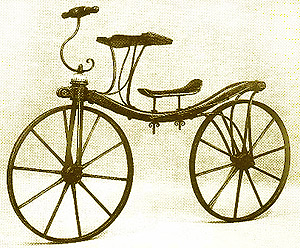
The vehicle then slowly morphed
via the cobbled streets and rutted roads into a 'Bone Shaker' so called because
of the extremely uncomfortable ride. This was a twin wheeled machine propelled
by pedals fitted to the front wheel. Like the Velocipede, the Bone Shaker was initially of all-wood
construction with metal 'tyres', later succeeded by a metal frame, metal wheels
and metal tyre. The pedals were attached directly to the front wheel. It
soon became realised that the larger the wheel, the farther it was possible to
travel with one rotation of the pedals. The rear wheel became less important and
subsequently reduced drastically in size/weight. Solid rubber tires and the long spokes
of the large front wheel provided a much more comfortable ride. The shape of this machine led to the nickname in the UK as the 'Penny-Farthing'
The Penny-Farthing, also known as a High Wheeler or the Ordinary, came into
vogue about 1870. They became very popular and and much used for about 20 years
until they were replaced by the rather aptly named 'Safety Bicycle'. With the
Penny-Farthing the rider sits high and nearly over the front axle. When the
wheel strikes rocks and ruts, or under hard braking, the rider can be pitched
forward off the bicycle head-first. Headers were relatively common and a
significant, sometimes fatal hazard. Riders coasting down hills often took
their feet off the pedals and put them over the tops of the handlebars, so they
would be pitched off feet-first instead of head-first. The invention of the
safety bicycle with chain and sprocket drive and pneumatic tyres, falling off was
a lot less painful and by 1890 the Penny Farthing was no longer made.
So if these have not been made since 1890, how come this Penny-Farthing as owned
by our Member Matt Tester is not the oldest
machine on these pages when compared with the Safety Bicycles described elsewhere.
Because his one is a brand NEW one. Matt says" I have always hankered after one since
being dragged out of bed on the 1st Sunday in November every year from an early
age and seeing a bloke riding one to Brighton. One day. One day. So at 50 it was
now or never.
 Matt
Tester at the Palace Matt
Tester at the Palace Matt
Tester hillclimbing Matt
Tester hillclimbing
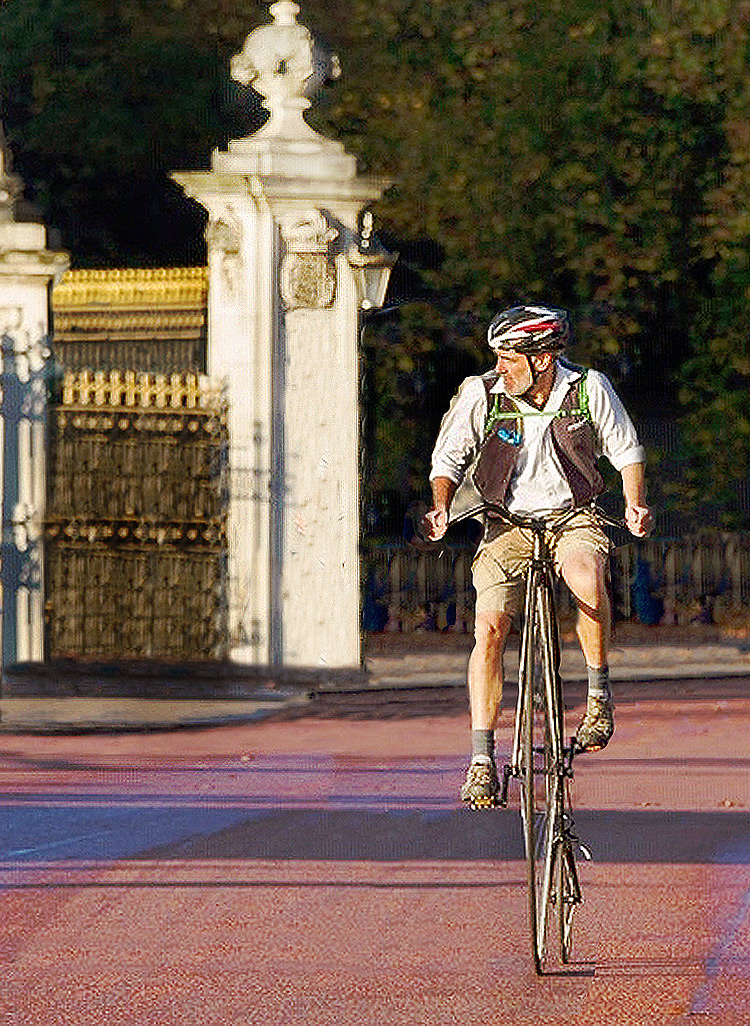
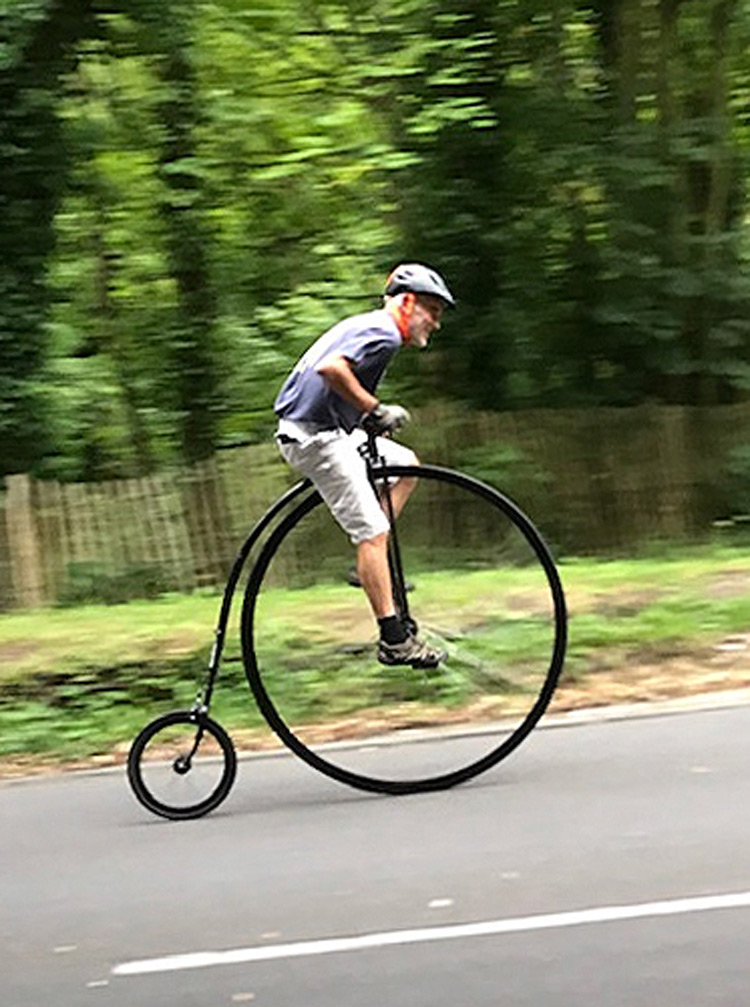
 Please
Click on the thumbnail photos to see the FULL SIZE picture Please
Click on the thumbnail photos to see the FULL SIZE picture
This one is a Penny Farthing made
and sold by Unicycle and purchased in 2016. It is made with a 54" wheel for a 34" inside
leg; a wheel that is too large or too small will result in an uncomfortable
ride. This a high specification racing Penny Farthing (Ordinary Cycle). The
frame is made from CrMo and has a moveable rear fork to allow change of front
fork rake for different riding preferences. It has standard double step, ideal
for coasting. There is an additional lower step that can be set to the left or
right to help mounting. It comes with a rear brake which helps control in
traffic and increases the usability and safety of the machine.
To start you put one foot on a step on the frame or 'spine', scoot along up to a
reasonable speed, climb onto the seat and push the pedal on the down-stroke.
Getting on the pedal too early on the upstroke on a fixed wheel results in a
'header'. Riding takes a bit of getting used to but is fairly simple once over
the gyroscopic effect of the front wheel. The view of the road is good. Plenty
of comments and attention so not really for the shy, It is the getting off, -
and knowing when, - that takes a bit of practice. For practice a big and ideally level
space is all you need to learn in.
"I've ridden it London to Brighton with the Veterans, the Pioneers and the
Cyclists " says Matt " I've raced it in London, Oxford, Washington DC via Heathrow and Eastbourne,
including hill climb from the sea front up to Beachy Head. This takes about 20
minutes. Coming back down again was easier. The bike has a brake in the spirit
of the idea on the back wheel, assisted by resting your shoe on the tyre to
'slow' you down. Brakes on the front tend to throw you over the handlebars,
called a 'header' and most riders control the speed by resisting on the
upstroke."
It seems the trick to learning to ride a penny farthing is just to not stop pedaling;
once you've built some momentum, it can be very hard to stop. So before you
climb aboard, you have to stand astride the back wheel, moving the bike forward
with kicks at the tarmac before making the jump. Pedaling is also weird. Each
push of the pedal makes the bike veer to the other side; pedal with your right
foot and it will veer to the left; pedal with your left and it will veer to the
right; zigzagging wildly. This can be partially compensated by pulling on
the opposite handlebar. Once mastered, speeds of 34 miles per hour have been
reached!
 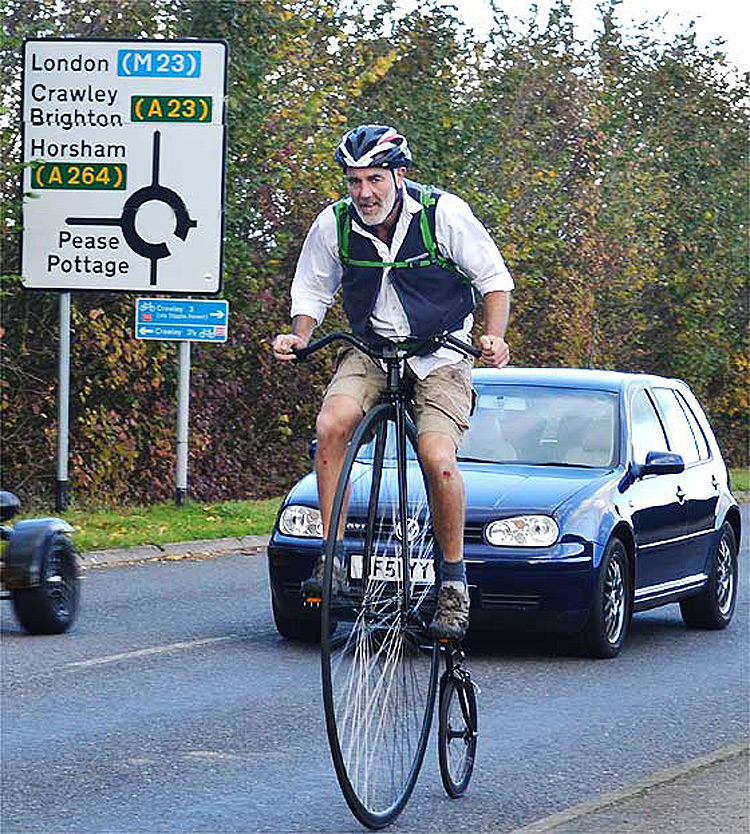
 Matt
Tester on the London to Brighton Veteran Car Run - Click to
enlarge Matt
Tester on the London to Brighton Veteran Car Run - Click to
enlarge
Having spent some time in France as a teenager, and lots
since, to me there are tree things that I think of when being asked to define
the term French: the Baguette, the 2CV and the Velo-Solex. Probably everybody
knows the Baguette and the 2CV, but what on earth is a Velo-Solex? Our French
Member Michel Gossett is
not a renowned boulanger, but he can contribute the 2CV and, until very recently, -
the Velo-Solex.
The Solex bit sounds familiar, and indeed it is. Solex was the French
manufacturer of circular radiators which was founded 1901 by Marcel Mennenson
and
Maurice Goudard in Neuilly-sur-Seine,
west of Paris. The Solex radiator was primarily used in commercial vehicles
including the De Dion Bouton Lorries and Busses since 1909. The Solex radiator
had the distinctive 'Mercedes type' large three pointed star logo on the the
circular front of the radiator which subsequently became the trade mark of all
Paris busses for years to come. Solex radiator was specified by the Paris CGO to
be fitted to all busses regardless of make. Hence there are now many errors on
the internet assigning the Mercedes name to unrelated busses and lorries. The
primary advantage of the Solex Radiator is that it is circular and tubular
with a flat bladed fan in the middle and surrounded by the cooling matrix, which
means more cooling air gets at the cooling surfaces of the tubes.
Sales of Solex circular radiators started to fall away after WW1 so the two
partners bought the patent rights from Jouffrett and Renée to establish
manufacture of carburetors instead. The carburetors were renamed as Solex and
were subsequently widely used by British and European car manufactures including
Rolls-Royce, Alfa Romeo, Fiat, Audi, Ford, BMW, Citroën, Opel, Simca, Saab,
Renault, Peugeot, Lancia, Land Rover Series, Lada, Mercedes Benz, Volvo,
Volkswagen, and Porsche. Over 10 million Solex carburetors were in use! Patents were
sold to to other parts of the world including Japan. It
also had a British operation which in 1961 had 1,700 employees.
It may also be worth noting at this point that our Michel Gossett
also has a direct connection with the Solex
operations of the time. One of Michel's two Jaguars, both with steering wheels
on the wrong side, is a 1955 Jaguar Mark Seven M which belonged to the then Solex
Managing Director Maurice Goudard as his personal transport but also was a mobile test-bed for
experiments with Solex carburetors. This is presumably why Michel also had to
have a Velo-Solex. So what is this Velo-Solex, and how come over eight million of
them were made? Possibly because it was an ultra-cheap motorised-bicycle
transport for the masses, including children. Minimum age14, basic
insurance, no driving licence, no driving test, no road tax and no registration
number, no helmet and no safety clothing. How could they
fail.
In 1916 Marcel Mennesson had obtained a patent to produce an auxiliary engine
located in the center of the rear bicycle wheel, and later a patent for a single
tube bicycle frame, a bit like a chunky ladies bike, but did not do much with
either of them. In June 1940 France was overrun by Germany which resulted in a
general fuel crisis. Solex Company's answer was to accelerate developing an
economical micro capacity engine to run on a bicycle. The first 38cc prototype
motor with direct drive was completed in 1941 fitted to an Alcyon men's bicycle.
In June 1943 the Vichy government helped by re-defining the categories of
Bicyclette à Moteur Auxilaire (BMA) into three newly qualified motor cycle
categories: Motorcyclette over 125cc, Vélomoteur between 125cc and 50cc, and
Bicyclette à moteur de secours (later called Cyclomoteur), under 50cc.
 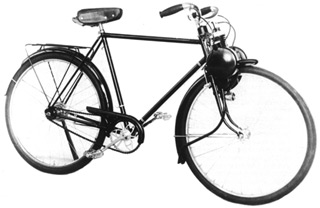
 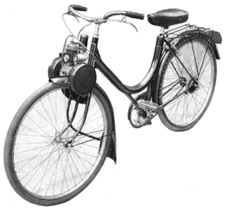
The first production Solex motorised cycle was
manufactured in 1946. The two-stroke engine capacity was increased to 45cc with
the engine to one side of the unit and fixed direct drive to the front wheel
through a grit friction roller, and sold as a complete machine with the engine
mounted at the front of cycle frame, over the front wheel. It was fitted with
the unorthodox floatless carburetor and a tiny diaphragm fuel pump operated by
crank-case pressure, and had a flywheel magneto-generator, which provides
current for ignition and lighting. It whole machine was named the VéloSoleX.
It very quickly became an 'instant success' including in the UK where it cost
£48. A road test at the tme in the UK, London to Brighton, advised: "....
the Velo-Solex commenced the long climb into Pease Pottage. Here early pedal
assistance was given, but it was possible to sit at ease on the sprung saddle,
with only one hand on the bars, while surmounting the hill. A relatively level stretch
led to Handcross Hill necessitated the rider's assistance, after which
occasional pedaling was called for in the undulating Wealden country. Then the
passage through the South Downs to Pyecombe where the Velo-Solex passed a
cyclist pushing his mount when at only a third of the way up. The Velo-Solex
covered the 55 miles 4 hrs,40 mins. The average speed of 11 3/4 m.p.h. would be
probably be equaled by a good sporting touring cyclist. A quick check
showed the petrol tank to be almost empty, which meant that, with a fuel
consumption of 205.5 m.p.g., the petrol for the trip had cost 6d.
By 1949 Solex were making 36,000 bikes a year, so selling about 100 bikes a day.
British Petroleum started to market "Solexine," a pre-mixed petrol/oil
mixture and by 1951 there is a network of 250 Solex petrol stations. The success
of the bike was phenomenal and deliveries become a problem; quicker to get one on
the black market rather than from dealers. Everybody in France had one or wants
one. Kids from 14 were scooting round town with noisy exhausts, students posing,
and grandpas with the bagettes in the carrier and a Gitane papier maiss incandescing
from the corner of their mouth.
In the next 69 years, and eight million units produced, the Velo-Solex, while
remaining visually relatively similar, underwent major changes too numerous to
mention here. It has been summarized by some, that in the world of
mopeds, the Velo-Solex ranks amongst the lowest performing with top speed of
18mph, dim lights, poor brakes and a friction drive liable to slip in the first
sign of wet, just a bicycle with a motor, rather than a serious moped. However
with a hint of nostalgia the Velo-Ssolex is really a symbol of freedom and the
ultimate in simplicity. It continues to be made as the
Solexity, a smart electric bike influenced by Pinninfarina.
The picture below is not of Michel Gossett
but it is of his ex Velo-Solex now owned by Andy
Coombes (of whom it is a picture), a close neighbour, occasional visitor to the SVVS and owner of vintage
Sunbeam motorcycles. Michel was pursuing the escape from coronavirus lockdown on
his bicycle (described on previous page) and was going past the Haycutter on
Tanhouse Road when he bumped into Andy in moderate flight on Michel's old 1974
Velo-Solex 3800 which he had recently adopted. He was trying to reach 10 mph but
the slight slope was resulting in him providing as much pedal effort as he was
getting from the engine. Apparently the culprit was the fuel pump which went on
holiday (or on lock-down?)
 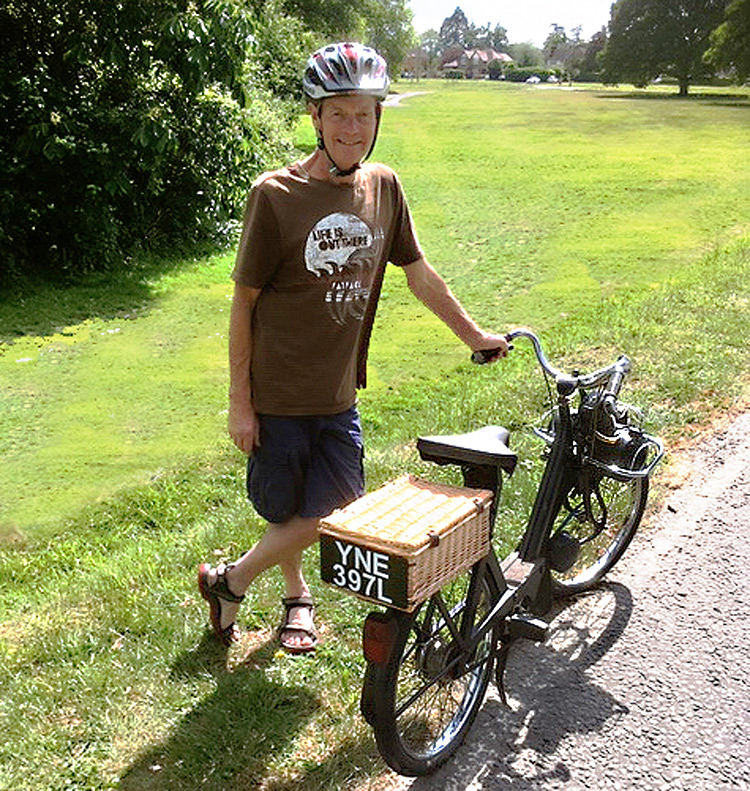
 Please
Click on the photos to see larger picture Please
Click on the photos to see larger picture
Michel advises he purchased his first Velo-Solex in 1961 for about 200 Francs,
the equivalent of about £20, which was several years of Christmas money. He
bought this Velo-Solex 3800 in 1995 for about £100. The Velo-Solex 3800
was introduced in 1966 and was made through to 1988. It had the third type of
frame, that of the 3300, being rectangular sheet folded and welded, but had an engine
giving a little more torque. This model was the first to be also available in
blue with white tyres as the "Super Luxe". This was done to combat competition
from the 'Velo-Vap'.
 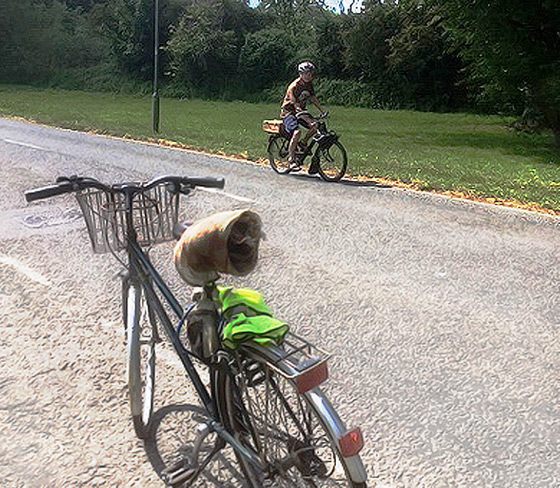
Chairman Bozi
Mohacek has the fondest of memories of the freedom
of the ' Velo' having lived in France in 1961 for a short while while a
student studying Automobile Engineering in Chelsea. : " An exchange visit
had been organised with the Grenoble University whereby students would spend the
Summer Semester in Grenoble working during the day in the auto industry and
spending afternoons studying French. My billet was the student accommodation in
the impressive tower of the mountaintop Bastille fortress overlooking the river L'Isere and
the town of Grenoble. The view from my window was mightily impressive. My place of employment was a big busy garage in town which
represented a major British car manufacturer. For reasons which will become
obvious I will refrain from naming them. My means of transport between the two
was le Patron's Velo-Vap.
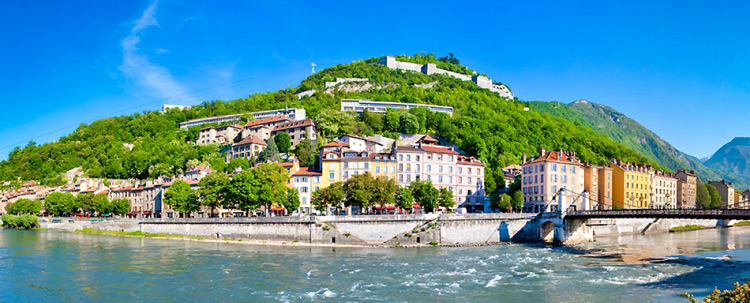
I recall that food was a problem on Sundays when the university facilities
closed for the evening. Breakfast was obviously missed because it was in the morning
which was designed for sleeping, so by the evening hunger was noticeable.
Fortunately the French being gastronomes, the Students Union opened their facilities in the town for supper. This
was always the same and delicious. On arrival in the dining room, packed with masses
of long tables and benches holding crowds of rowdy students, you collected a
number of baguettes, quantity relative to the degree of hunger, and find a table where
there were numerous massive bowls of Fondue. The principle was to dunk the end of the
baguette into the bubbling cheese and eat, invariably burning the mouth and
leaving long strings of coagulating cheese over the table! The
bowls just kept on coming.
 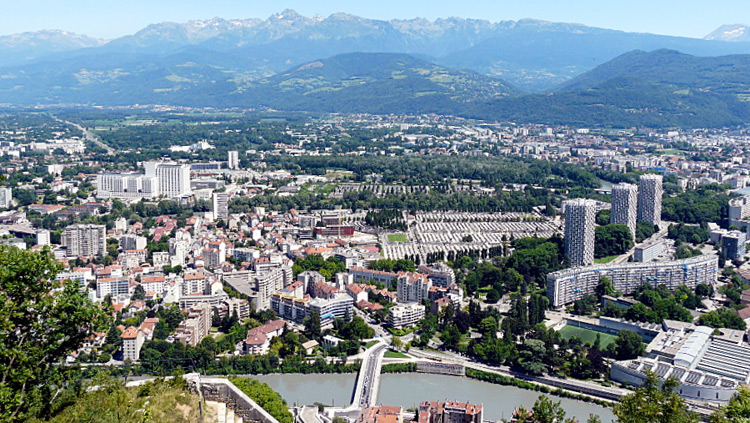
 Please
Click on the photos to see larger picture Please
Click on the photos to see larger picture
I was supposed to be employed as a garage mechanic because I understood right
hand drive, Whithworths, BSW and BSF but I was given a French owned 2 CV Citroen as the first
car I was to service. Having never actually 'serviced' a car, this was a
daunting task in itself, but to have to do it to an air cooled motorcycle
engined bedspring was quite another. Also, nobody had bothered to tell me that
the 2CV in question had a centrifugal clutch. So when I revved up the engine the
car shot forward and considerably discolored the wall. I was subsequently
put on less mechanical duties and spent most of my time acting as interpreter
for the many Brits who had been towed-in while trying to climb the adjacent Alps
in their underpowered underserviced Bbritmobiles and wondering why their cars
consistently boiled and blew headgaskets while trying to surmount the hills in
top gear. Grenoble was tucked into the French Alps en-route to most of the
alpine passes to Italy. In those days there were no tunnels through the Alps so
the only way to get to Italy was to go up and over.
As mentioned, my method of transport between the la Bastille and the garage was
le Parton's Velo-Vap. For many years since I have not been able to find any
photographs of my time in Haute Savoie or any showing the machine. The Velo-Vap
Company made
two types of bikes; a lookalike to the Velo-Solex and a mobillette type. I could not
remember which type I had but it was much faster than the Solex. Eventually just
now after much searching I have found a photo!
 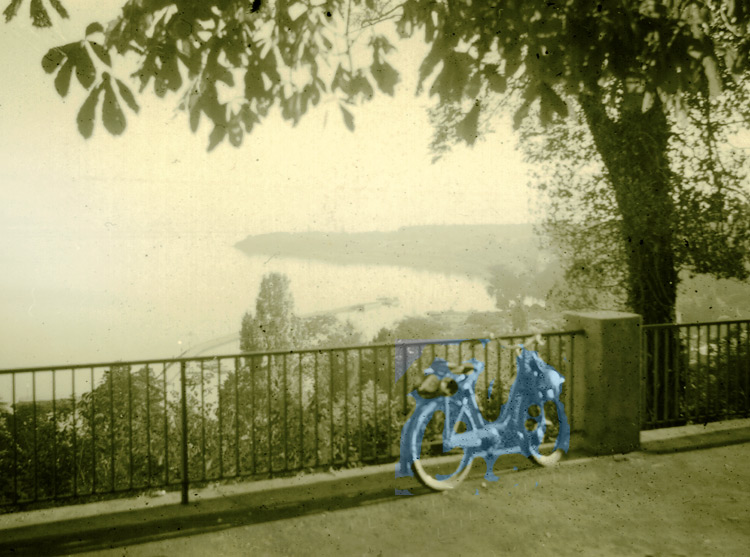
Velo-Vap was Velo-Solex's main competitor between 1958 and 1968. The primary immediate
difference between the two was that the Vap was blue, rather than the Solex
black. The Velo-Vap was made by the Société VAP, known since 1949 for bolt-on
engines for bicycles, and was named after the designers Verot and Andriot
Pierre. The Velo-Vap had a more powerful engine capable of ascending hills
without pedalling, but it was considerably more expensive which contributed to
the relatively short production run. About a 100,000 were made in two factories
in France at a rate of 100 a day. About a third were exported to Switzerland and
Great Britain, Although still only 50cc it was rated at 1.5HP and was capable of
cruising at about 30-35 km/h. It had a twist-grip accelerator and an automatic
clutch so did not stall at each traffic-light. One of the reasons for its demise
was the introduction of compulsory crash helmets.
During my stay in Grenoble I clocked up a considerable mileage on this
lovely nippy little machine. Much faster and more comfortable than the
Velo-Solex and I have almost no recollection of ever having to pedal it. I spent
most of my weekends tootling off to Alps or to Lake Annecy or lake Aix-les-Bains
either solo or with friends with similar machinery. All very peaceful, unhurried
and unstressed. I also remember a memorable solo trip to the further-off Lake
Geneva and the town of Thonon-les-Bainss where I arrived
late evening; I think the photo above is from that trip. Having no money or time to find accommodation for the night I went
into the harbour and crept into one of the boats part-pulled out on the slip and
covered over with a tarpaulin. At the crack of dawn I began to feel a bit
shaken-about so peered out from under the sheet to find that the boat had
slipped and had drifted out into the lake. Took some time to work out which bit
of the shore to get back to in order to find where I had left the Velo-Vap.
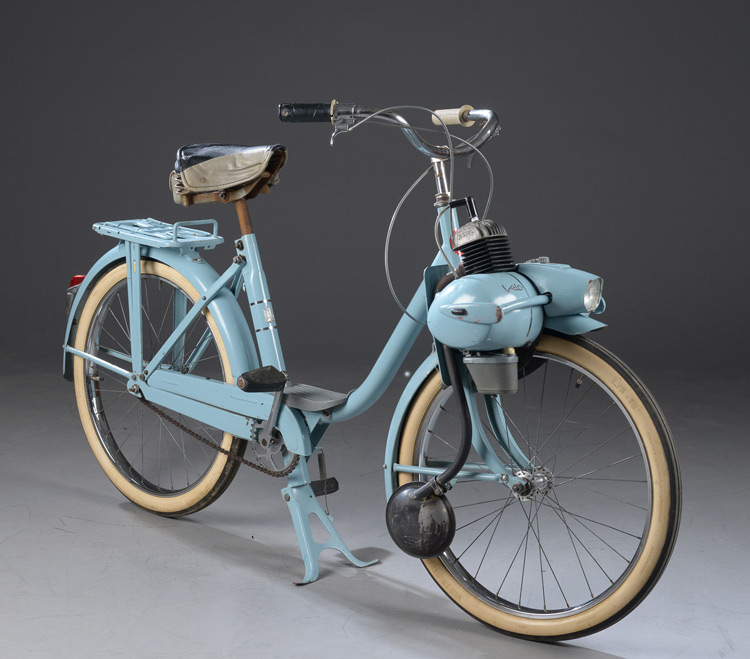
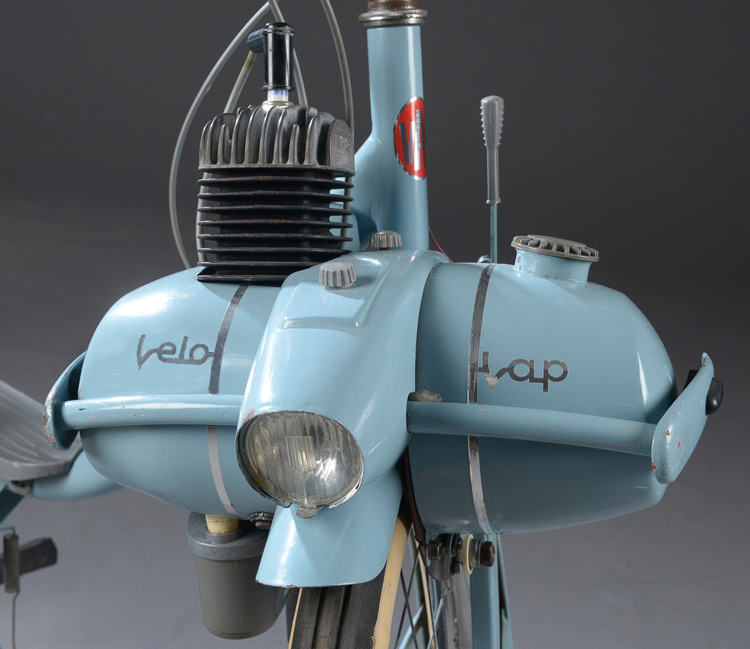
 Please
Click on the photos to see larger picture Please
Click on the photos to see larger picture
Go to Recent Venues
Page
PICTURE GALLERY INDEX
|
